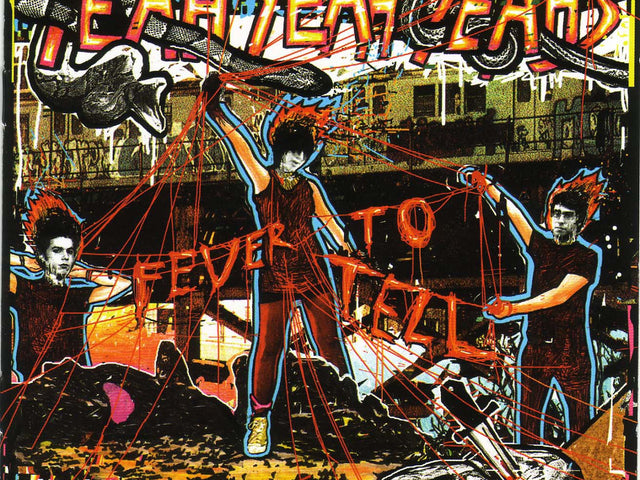メタルリミックスアルバムは、ギターを基にしたヘビーミュージックが多様なジャンルからアイデアを取り入れて視野を広げていた時代に誕生しました。その結果は、正直なところ、時にはかなり微妙でした。他の時には、本当にワクワクさせる、過激で画期的なものでした。インダストリアルメタルやラップメタルのようなサブジャンルは、シンセサイザー、サンプラー、シーケンサーなどの非伝統的な機器の使用が増えることで、歌ったり吠えたりリフを演奏する新しい方法が発見されるにつれて存在感を増しました。
Remix culture played an important role in this merging of different musical worlds, with dance or dub reinterpretations helping to introduce musicians and listeners to bold new sonic pathways.
Yes, the remix album can often be a fairly pointless and cynical cash-grab opportunity. Nobody on this entire planet needed or wanted Deconstructed by Bush. That being said, there are some genuine classics out there, especially where metal is concerned.
Because the heavy metal remix album’s heyday coincided with the peak of the compact disc era, several classics remain unavailable on vinyl. At the time of writing, there has sadly never been a wax pressing of Nine Inch Nails’ Further Down The Spiral, a record so important that the underground electronic artist Lana Del Rabies recently credited it with changing her entire outlook on life. There have been more recent efforts, too, which have only had CD or download editions, including Melvins’ mad Chicken Switch collection on which its remixers used elements from more than one song. In lieu of oversights such as those, here are the metal remix albums which most merit a place on your turntable.

Nine Inch Nails: Fixed
The Broken mini-album is often cited as the creative breakthrough for Nine Inch Nails. It captures that moment when Trent Reznor’s project escaped the cheesier synth-pop sound of its earliest incarnation and transformed into a harder, denser and murkier prospect. In some ways, Broken’s remixed sequel is of equal importance to the development of Nine Inch Nails’ fierce industrial sound.
The guitar-based original compositions were twisted and manipulated into pounding beat-oriented affairs with writhing, unpredictable structures. Not only did Fixed push Reznor’s music into uncharted territory and establish an ongoing affinity with the noisy underground at a time when Nine Inch Nails were about to explode in popularity, Fixed also acted as the gateway through which adventurous listeners were introduced to the weird worlds of its contributors, including Coil and JG Thirlwell.

Fear Factory: Fear Is The Mind Killer
If there is one band perfectly suited to the remix format, it has to be Fear Factory. They were already one of the first groups to blend death-metal heaviness with industrial electronics, plus each successive album had a man-vs-machine concept basically matching that of the Terminator franchise. Overseen by Rhys Fulber and Bill Leeb of Front Line Assembly, Fear Is The Mind Killer took a handful of standout tracks from Fear Factory’s 1991 debut LP and created a succinct but satisfying accompanying piece. These weren’t sweeping structural metamorphoses like the tracks on Nine Inch Nails’ Fixed. Rather, Fulber and Leeb applied a slightly subtler approach, embellishing the tracks with loops, samples, techno beats, and other effects. By keeping heaviness central to the remixes but upping the electronic quota, Fulber and Leeb provided clear guidance for the direction of Fear Factory’s landmark second LP, Demanufacture.

White Zombie: Supersexy Swingin’ Sounds
Rob Zombie has been accused of ripping his whole shtick off Al Jourgensen from Ministry. Zombie’s band certainly embraced industrial metal a number of years after its sound has been pioneered by Ministry. There were also noticeable sartorial similarities between the two band leaders: scruffy dreadlocks, pitch-black sunglasses, long leather overcoat, big hat. If Zombie has one thing over Jourgensen, he got his remix album out first. With White Zombie announcing their split not long after its release, Supersexy Swingin’ Sounds would turn out to be the band’s swansong. It wasn’t a bad one to go out on, either. The album has its critics but at a time when The Prodigy and The Chemical Brothers were starting to make waves, this album’s fusion of groove-metal riffs and dance-floor beats felt pretty exciting and very contemporary. True, even the band’s own bassist Sean Yseult once described it as “Super Sexy Swinging Bullshit.” She also confessed to having never listened to it. Perhaps Yseult should give it a chance. If not strictly a sexy album, much of it is banging.

Front Line Assembly Vs. Die Krupps: The Remix Wars Strike 2
Here’s a more novel approach to the remix format: two bands tackle each other’s tracks, presenting the results as a split release. This edition in the Remix Wars series featured two heavy hitters of the 90s industrial scene. Canada’s Front Line Assembly were formed by Bill Leeb after he quit Skinny Puppy. Germany’s Die Krupps were trailblazers for what became known as EBM (or “European Body Music”) and are also notable for having released a synth-based collection of Metallica cover versions described by at least once critic as “a travesty.” Of course, there are few things more satisfying than annoying Metallica purists, as everybody knows (not least Metallica themselves). Anyway, the point is, you’d be hard pressed to find a more appropriate pairing. The jury is out over which side is best — Front Line Assembly’s mutations of Die Krupps or Die Krupps’ dislocations of Front Line Assembly? One thing is for sure: As aggressive and warped as much of this material is, you can tell each act is having an absolute ball throughout.

Godflesh: Love And Hate In Dub
The British metal press didn’t always understand or appreciate it but industrial metallers Godflesh were obsessed with hip-hop. As the band’s Justin Broadrick once put it, “Given the choice between Venom, Emperor or some other black metal band, and KRS-One, Jeru or the Wu-Tang — you know which side I’ll pick.” Godflesh initially hoped to recruit such rap superstars for the remixing of tunes from 1996’s Songs Of Love And Hate. Alas, after a few brief calculations it became clear that the idea would prove far too costly. Instead, Godflesh remixed everything themselves, providing their own skewed take on experimental hip-hop and dance music production techniques. The dynamic results, Broadrick felt, surpassed the quality of the source material, leaving the original version of Songs Of Love And Hate sounding “flat in comparison.”

Earth: Legacy Of Dissolution
Earth are best known for inventing drone metal in the early ’90s, then taking a lengthy drug-induced hiatus before returning with a freshly distortion-free but still extremely slow spaghetti-Western style in the mid-2000s. Befitting the comatose aesthetic of Earth, the respectful remixes on Legacy Of Dissolution are less suited to the discotheque than for the purposes of deep meditation or, perhaps, to provide the perfect ambience for passing out on a chaise longue in your favourite opium den. Even Autechre, who have been known to create some of the most intense, complex and busiest IDM works out there, take an eerily delicate approach to “Coda Maestoso in F(Flat) Minor.” Other revered contributors include Mogwai, Russell Haswell and Justin Broadrick. Drone-metal superstars Sunn O))) also make an appearance, only too aware they owe a little more to Earth than any mere remix can expiate.

Isis: Oceanic Remixes / Reinterpretations
Released in 2002, Isis’ second album remains one of the greatest post-metal albums of all time. Following its release, the band were keen to explore the more abstract and electronic side of their tastes but decided this would be better realized by more experienced and capable practitioners. Thus, Isis enlisted such important electronic names as Venetian Snares, Tim Hecker and Fennesz, with the results ranging from evasively ambient to still-very-heavy-indeed. One surprise star gracing the tracklist is Mike Patton, vocalist for Faith No More, Mr Bungle, Tomahawk and 20 million other projects. Patton transforms the relatively soft “Maritime” into something gouged straight out of the warped skull of a haunted doll. Naturally, the omnipresent Justin Broadrick also contributes, his stifling 15-minute extended take on “Hym” closing the record in style.

Einstürzende Neubauten: Ende Neu Remixes
It won’t have been difficult for Einstürzende Neubauten to assemble a group of respected remixers to devotedly rework these tracks. If not exactly a household name (unless you live in a particularly cool household), Einstürzende Neubauten’s influence stretches far and wide. Famed for making a clattering racket using power tools and construction materials, the post-krautrock noiseniks inspired Martin Gore to plunge Depeche Mode into darker and weirder territory. Nick Cave was in awe of leader Blixa Bargeld as soon as the pair met, quickly enlisting the enigmatic German to join The Bad Seeds. And, for better or worse, Rammstein would not exist without Einstürzende Neubauten.
Sixteen years after forming, Einstürzende Neubauten’s 1996 album Ende Neu was characterized by a maturing of their sound and even included a ballad. Its remixed equivalent boasts contributions from Barry Adamson, Jon Spencer, Pan Sonic and Techno Animal (i.e. Kevin Martin in league with, you guessed it, Justin Broadrick). Whether providing a lush take (Soulwax) or driving the music into a harsh jungle direction (Panacea), each act brought their own distinctive character to the table, resulting in a satisfyingly diverse collection.

Grinderman: Grinderman 2 RMX
Speaking of Nick Cave... All right, some readers may question Cave’s metal credentials because he plays the piano way too often, but let’s take a look at the facts. He only ever wears black. He’s obsessed with death, shotguns, swamps, the electric chair, Bibles and the blues. That’s all pretty metal if you ask me. His short-lived Grinderman project, meanwhile, was described by one journalist as “heavier than heavy metal.” Like his buddies Einstürzende Neubauten, Cave will have had little trouble enlisting big names to transform the songs from Grinderman’s second album. Prog legend Robert Fripp adds some scorching guitar work to a new version of “Heathen Child.” Andrew Weatherall’s version of the same song has a funkier dub feel. A Place To Bury Strangers slap some phat beats and lysergic effects onto “Worm Tamer.” Josh Homme’s version of “Mickey Mouse & The Goodbye Man” is particularly surprising. It’s weirdly minimalist, stripping away much of the original’s heaviness in order to accentuate the vocals, bass, and a creepy ticking noise as if the crocodile from Peter Pan has given up on Captain Hook and is now hungrily pursuing Nick Cave.

Pale Sketcher: Jesu - Pale Sketches Demixed
Broadrick again! This time Uncle Justin appears under his Pale Sketcher guise, remixing tracks from his own Jesu project, the post-metal-meets-shoegaze outfit he formed after Godflesh split. The original LP was a compilation of non-album songs recorded between 2000 and 2007. The tracks in question were pretty atmospheric, electro-tinged and textural in the first place, like a metal band that had become submerged in a cloud of trip-hop spliff smoke. Unafraid to alienate an even greater proportion of his fan base, Broadrick’s so-called “demixes” slink even further away from metal territory until they begin to resemble the quieter end of Aphex Twin or something which could have oozed out of Boards Of Canada’s laptop in the dead of night.
JR Mooresはイングランド北部を拠点としたフリーランスライターです。彼の作品はNoisey、Record Collector、Drowned In Sound、Bandcamp Daily、The Guardianなどに掲載されており、現在はThe Quietusの常任心理ロックコラムニストを務めています。
Related Articles
クラブに参加!
今すぐ参加、44ドルからExclusive 15% Off for Teachers, Students, Military members, Healthcare professionals & First Responders - Get Verified!










